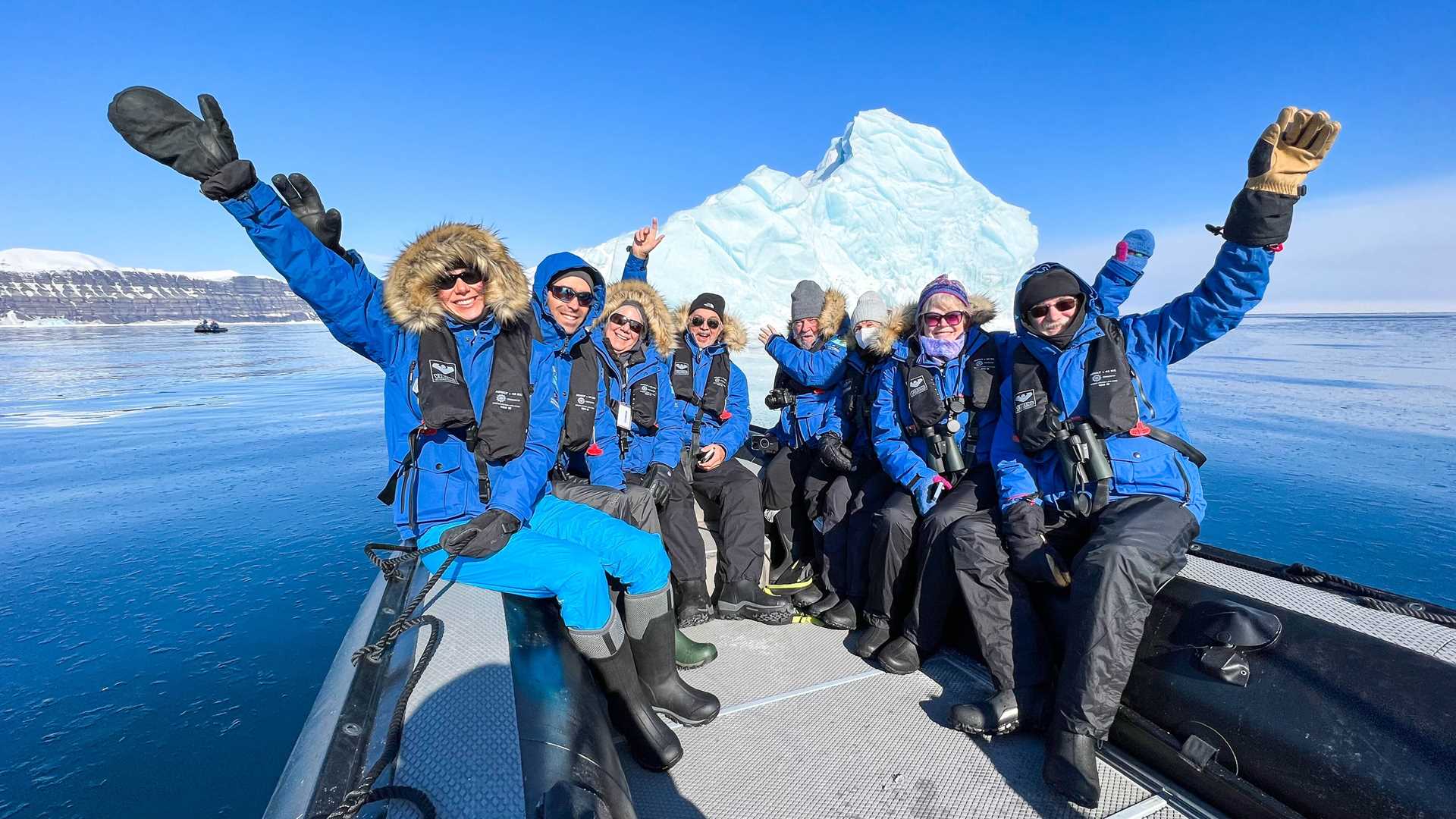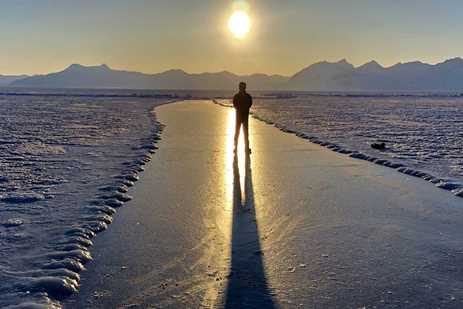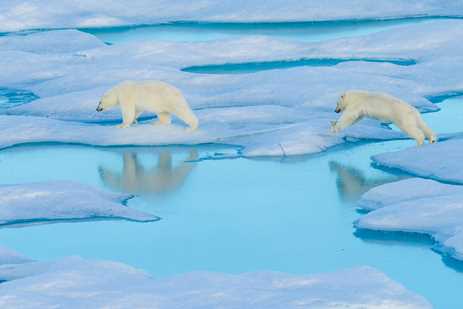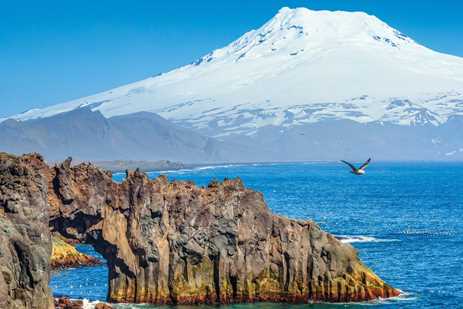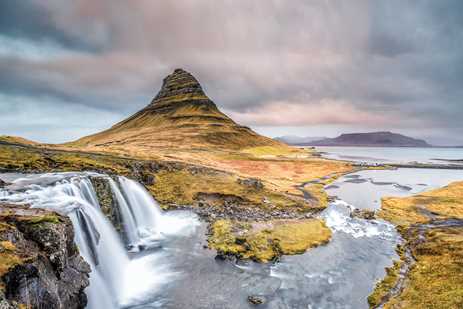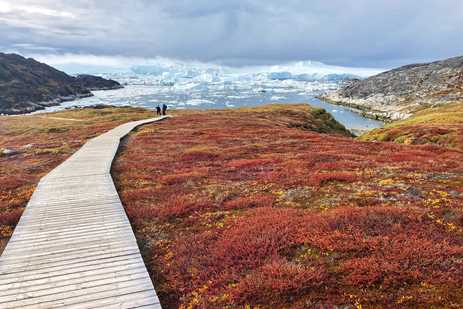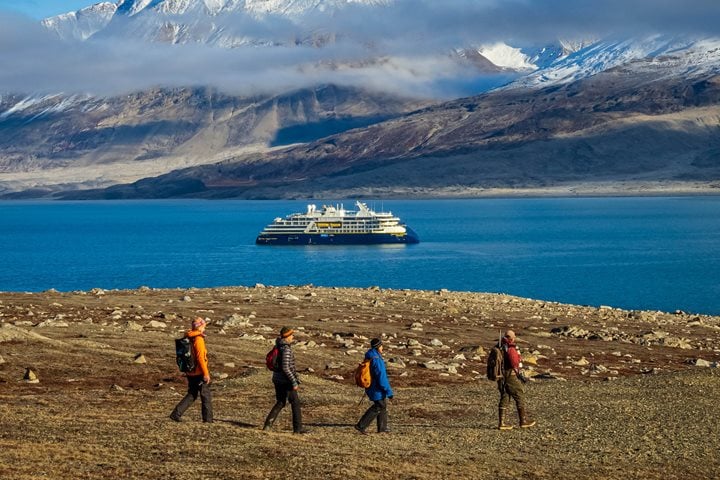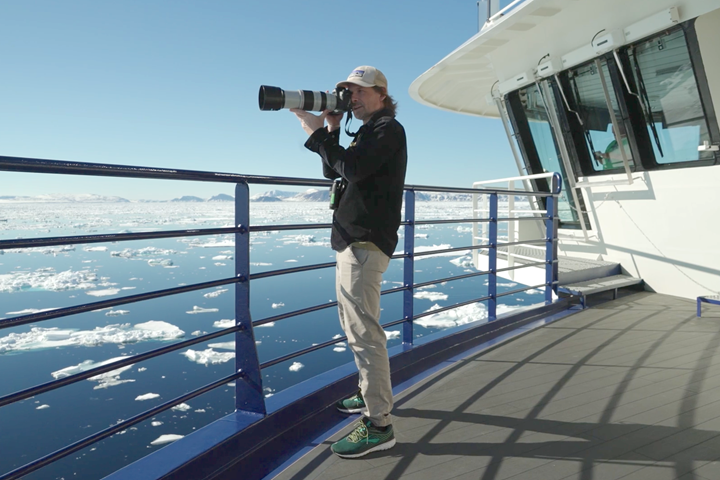Call +1.800.397.3348 or contact your travel advisor
From spotting polar bears to kayaking in magnificent fjords, Arctic expeditions offer an array of exhilarating adventures in one of the most remote parts of our planet. To enjoy these activities to the fullest—and to stay safe under changing conditions—you’ll need to be well prepared for the weather at the top of the world.
Curious travelers have been experiencing the wonders of the Arctic with Lindblad Expeditions-National Geographic for decades. Here is our packing list, along with an expert guide on what to wear on an Arctic cruise.
Arctic Expedition Packing List
- A hooded, insulated, and water-repellent jacket.
- Note that on our voyages, a complimentary parka or jacket is provided to travelers.
- Waterproof rain jacket for rainy or windy weather that is too warm for a parka
- An assortment of fleeces, sweaters, turtlenecks, t-shirts, and other layered clothing
- A pair of waterproof pants, loose enough to wear over a regular pair of trousers
- Two or three pairs of warm, casual wool or fleece trousers to wear under your waterproof pants
- A set of thermal or silk long underwear
- A pair of fully waterproof knee-high rubber boots with sturdy, high-traction soles
- Comfortable, rubber-soled walking shoes for use on board and during shore excursions
- Three or four pairs of warm, sturdy, and tall wool socks
- Three or four pairs of thin socks to wear underneath tall socks for extra insulation
- One or two pairs of waterproof ski mittens or gloves
- A pair of thin, polypropylene gloves that fit under your ski mittens
- Ski cap or balaclava
- Scarf
- Bathing suit for use in the ship saunas and hot tubs, or for the invigorating polar plunge
- Exercise clothes and sneakers to partake in the onboard gym facilities
- One or two pairs of sturdy sunglasses with UV protection
- An extra pair of prescription glasses or contacts
- Personal toiletries, including sun block, moisturizing lotion, and lip balm
- Comfortable walking stick for use on uneven or icy terrain
- Camera and gear, such as lenses, memory cards, and extra batteries
- Binoculars
- Small waterproof/repellant backpack or rucksack for shore excursions
- Extra prescription medications (enough for double the expedition length)
What to Wear at the Arctic Circle
The proper clothing for an Arctic cruise combines specialized Arctic expedition clothing with items you might already have in your closet, especially if you live somewhere that gets cold weather.
We provide the bulkiest and most critical item to guests aboard our Arctic expeditions: every traveler receives a complimentary parka that they can take home with them at the end of the journey.
But you will need additional Arctic cold weather gear to stay warm and dry as you explore the region’s icy and rugged landscapes. Here are some factors to keep in mind when selecting clothing and accessories for your Arctic expedition.
Dress in Layers
When it comes to how to dress for the Arctic, wearing layers is key. Temperatures can change quickly and vary widely, and multiple layers are the most efficient way to prepare for these fluctuations.
Layers should be lightweight and loose. Warm air becomes trapped between layers and acts as insulation—but it can also be detrimental, as sweat cools the body. By being able to add and subtract layers as needed will allow you to expertly regulate your body temperature.
Here are four types of fabrics that work well for layering.
Waterproof Fabrics
Staying dry in the Arctic is often equivalent to staying warm. Since sweat and wetness can exacerbate a chill, waterproof fabrics are your best protection from snowy or rainy conditions, and from water that can splash during Zodiac landings.
Windproof Shells
Wind strips warm air away from your body, so it’s important to pack a windproof outer layer or shell. For example, on a 0-degree Fahrenheit day with wind blowing at 15 mph, the wind chill makes it feel like -19. When the outer layer of your Arctic clothes is windproof, it will keep you warmer.
Breathable Materials
When thinking about what to wear in the Arctic Circle, make sure to consider breathable fabric. Natural fabrics such as silk and wool are best, but many high-tech synthetic fabrics have been engineered for breathability.
Although cotton, another natural fabric, may seem like a proficient insulator, when it gets wet it’s much less effective so it’s best to avoid.
Wicking Fabrics
Moisture-wicking fabrics draw dampness away from your skin to the outer side of the fabric, keeping skin dry so your body can better regulate its temperature. Most moisture-wicking fabrics are synthetic, but wool is a good natural alternative.
Polar Expedition Clothing Packing List: What to Pack for an Arctic Cruise
In this section, learn more about the best Arctic coats to pack as well as the proper pants for the Arctic, gloves for the Arctic, Arctic boots, and more.
These items are all essential for exploring in polar climates and they’ll keep you comfortable while you’re enjoying some of the Top Things to Do in the Arctic Circle.
Best Jacket to Wear to the Arctic Circle
An Arctic coat is the first thing to consider when you’re thinking about how to pack for an Arctic cruise. To protect against extreme weather conditions, the best Arctic expedition jackets are hooded, insulated, and water repellent.
Every guest on an Arctic voyage with Lindblad Expeditions-National Geographic receives a complimentary parka upon boarding the ship. Our Arctic coats come in a vibrant blue hue, chosen for its high visibility against the snowy white landscapes.
Outer Shell
The term outer shell refers to the outermost layer of your Arctic ensemble which helps shield you from the elements. So on top that would be your parka, while a pair of rain pants completes the bottom half of your shell. The outer shell should be weatherproof, protecting you from wind, icy water, and cold temperatures.
Inner Liner
Many Arctic parkas come with an inner liner that may or may not be removable. Guests who choose an outer shell with an inner liner are typically the most comfortable and prepared for Arctic weather conditions.
The parkas provided by Lindblad Expeditions-National Geographic have a removable liner jacket which you can wear on its own if the shell becomes too warm.
Waterproof Pants for Exploring the Arctic Circle
The best waterproof pants for the Arctic repel water and wind. Look for GORE-TEX® or a similar durable, breathable fabric, and make sure that your waterproof pants for the Arctic are large enough to fit over warm trousers and long johns. Many travelers find that ski pants are a good option for this outermost bottom layer.
If you don’t plan on wearing your waterproof pants after your voyage, they may be rented from our gear provider, Ship to Shore, and delivered to your cabin. Ship to Shore’s waterproof pants feature a drawstring waistband for a custom fit and wide legs with snap closures that fit over boots and protect you from water seepage.
Warm Expedition Gloves or Mittens for Polar Climates
Since your extremities are usually the first to feel cold, waterproof hand protection is critical. The best gloves for the Arctic are worn in layers. Consider wearing a pair of thin, polypropylene gloves under your ski mittens. This allows you to take your mittens off and take photos without exposing your bare hands to the elements.
Headgear for Cold Weather: Winter Hats and Balaclavas
Up to 90 percent of body heat can escape through your head, so you’ll want a wool ski hat that covers your ears and forehead. A balaclava, which can be pulled down to cover your face and neck, is another good choice.
Headgear made of synthetic material like polypropylene or Polartec® is great at repelling water and containing body heat.
Boots for the Arctic: Muck Boots or Wellington-style Rubber Boots
Knee-high rubber boots are the best boots for the Arctic. Make sure they are completely waterproof to avoid seepage when you step into shallow, icy water during Zodiac landings.
Additionally, Arctic boots should have sturdy, high-traction soles to keep you steady when hiking across ice or rough terrain. Be aware if your boots are too heavy or bulky they can impede hiking. As an alternative to purchasing or packing knee-high boots, we offer the opportunity to rent them through Ship to Shore.
Along with rubber boots, you may also want to bring another pair of Arctic shoes. Consider packing insulated, waterproof walking boots which are great for exploring non-icy terrain in places like Greenland or Iceland. An inside tip: Insoles in any type of footwear provide additional comfort and warmth.
Cold Weather Socks for Arctic Cruises
As with gloves, the best socks for the Arctic are worn in layers. Opt for a pair of thin socks made of a fabric like silk, polypropylene, or merino wool underneath a pair of tall, thick, wool socks. This combination ensures the best insulation.
Base Layers: Long Underwear
An essential clothing item is a set of long johns to wear as a base layer. They should be at least medium weight and include a long-sleeved thermal top and pants made from fabric such as merino wool, silk, or a synthetic blend.
Sweaters or Polar Fleece Jackets
In addition to a base and an outer shell, additional layers will be useful, depending on the day’s activities. A polar fleece jacket is easily zipped up or removed as the weather warrants, and sweaters of different weights will suit a variety of conditions.
Wool or Synthetic Scarf
Wind and rain can quickly break through your outer shell if your neck is exposed. Bring a wool or synthetic scarf to ensure your neck is protected, even if your parka has a hood.
Onboard Attire for Expedition Cruises in the Arctic Circle
The dress code aboard ship depends on the travel company you choose. Some cruises may have a formal evening that requires you to dress up.
That is not the case on a Lindblad-National Geographic expedition. The atmosphere aboard our voyages is casual and comfortable and there’s never a need to pack a formal outfit. Onboard attire typically includes items like casual pants, fleeces, and sweaters.
Learn more about life on board our fleet.
Turtlenecks or T-shirts
Sweaters and shells will likely be too bulky or warm for relaxing in the lounge or eating in the dining room, so you’ll want to bring a few lighter options like turtlenecks and t-shirts. You can easily pair them under a zip up fleece or sweatshirt which you can take on and off as needed. Don’t forget workout gear if you plan to take advantage of the onboard gym.
Casual Pants or Slacks
The wool or fleece pants you wear in between your long underwear and rain pants will work well for hanging out on the ship as well as when you’re exploring on shore. You also can’t go wrong with a pair of jeans, leggings, khakis, or other casual pants.
Comfy Shipboard Shoes
For time aboard the ship, we recommend sturdy, rubber-soled footwear, such as sneakers, walking shoes, or hiking boots, that can help prevent slips, especially when out on deck observing wildlife or taking in the scenery.
Arctic Circle Accessories to Pack
In addition to clothing, there are other items that should be on your Arctic packing list. Some items, like a camera and sunglasses, may seem obvious, but others, like sunblock, might not be as apparent.
Daypack or Backpack
Bring a small, waterproof backpack on daily excursions to store your camera, binoculars, and extra clothing layers. Make sure you can wear it in a way that keeps your hands free for safe entry and exit from the Zodiac.
Camera with Charger
The awe-inspiring beauty and wildlife of the Arctic—as well as the access to our unique Expedition Photography program—make packing a camera essential.
A Lindblad Expeditions-National Geographic certified photo instructor travels on board each of our voyages to assist travelers with everything from camera settings to composition, and to help you capture the photos of a lifetime.
Learn more about our Expedition Photography program.
Batteries, memory cards, cables, and chargers are also important to pack. In addition, other accessories such as a laptop computer, portable hard drive, and jump drive can help store and organize all your photos.
Binoculars
In the Arctic, wildlife such as polar bears and reindeer are most often seen in the distance, so a good pair of binoculars is another must-have. We recommend full-sized binoculars with a center focus. Those that can be close focused to 15 feet or less and that are rated 7x35, 8x40, or 10x40 are among the best for wildlife viewing.
Weight and optical quality vary widely, and better quality comes at a higher cost. Zeiss, Leitz, and Swarovski are considered top-of-the-line manufacturers and generally warranty their products for life.
Sunglasses
The brightness of the summer sun reflected off the Arctic ice can pose a risk to unprotected eyes. Bring sturdy, high-quality sunglasses with UV protection—plus, a backup pair in case one breaks or gets lost. Polarization adds extra glare protection, and tinted ski goggles work well in particularly windy and wet conditions.
Extra Pair of Prescription Glasses
If you wear prescription glasses or contacts, bringing an extra pair will ensure that you will still be able to fully enjoy your Arctic expedition if your primary pair breaks or gets lost.
Sun Block
The reflected glare from snow, ice, and water in the Arctic can make skin vulnerable to sunburn. Apply sunscreen on your face and other exposed areas, and protect your mouth from the elements by using SPF moisturizer or lip balm.
Bathing Suit
Some ships, like those in the Lindblad Expeditions-National Geographic fleet, have a sauna and/or infinity hot tubs aboard so bring a bathing suit on your voyage to take advantage. You’ll also want a swimsuit if you plan on taking part in the ritual polar plunge, a badge of honor for many Arctic explorers.
Collapsible Walking Stick
Collapsible hiking poles can be helpful for maintaining balance and increasing leverage on icy or uneven Arctic terrain. They can also increase endurance by distributing weight. Collapsible hiking poles can be rented and delivered to your cabin through our gear partner, Ship to Shore.
Medicines
Bring any prescription medications and over-the-counter remedies in sufficient quantities— enough for double your expedition length, when possible as a precaution.
While seas are expected to be generally calm, and our ships are fully stabilized, motion affects everyone differently. You may want to bring some preventative medication if you are susceptible to motion discomfort; check with your doctor for recommendations.
Journal
Journaling is a wonderful way to capture special moments. Writing about or sketching what you see and feel can help you remember details when you share your adventures with friends and family back home.
What to Wear on an Arctic Expedition Cruise FAQs
Guests new to Arctic expeditions may require professional advice on what items and fabrics to wear, as well as where to shop for Arctic gear and which brands to buy.
Here, our experts provide answers to frequently asked questions.
What Brand Do Arctic Explorers Use?
Explorers arrive in the Arctic from all corners of the globe, and the brands they use vary by the type of gear and personal preference. Some of the most popular gear brands among professional Arctic explorers include: The North Face, Patagonia, Orvis, Columbia, Arc’teryx, Canada Goose, Helly Hansen, and Craghoppers.
Where Should I Buy My Clothing for My Arctic Cruise?
It’s best to go in person to a store like REI that specializes in outdoor adventure. That way, you can speak directly to a knowledgeable salesperson, who will help you find clothing and gear suited for your destination and planned activities.
How Many Layers Do You Wear in the Arctic?
We suggest wearing three or four layers, both on top and the bottom. On top, these include a base layer of thermal underwear, a long-sleeved shirt, and a fleece, all topped off with an Arctic parka.
Leg layering should again start with long johns, followed by casual trousers, then waterproof pants as an outer shell.
What Kind of Jacket to Wear in Antarctica?
The principles of selecting a jacket for Antarctica are the same as the Arctic. Polar expedition jackets need to have thick insulation and a hood and be water repellent.
Lindblad guests receive a complimentary parka, delivered directly to the ship, for use during the expedition. For safety, our Antarctic parkas are red to be easily spotted against the snowy white landscapes.
Which Fabric is Warmest in Winter?
Synthetic fabrics like Polartec® and polypropylene have been specially engineered to be warm, lightweight, and moisture wicking. Natural fabrics such as silk and wool when worn together in layers also insulate the body well in the Arctic climate.
Now that you know how to pack for your Arctic expedition, you may be interested in learning more about some of the destinations we visit in the region. For instance, you can discover 5 Things You Didn’t Know about Longyearbyen or What to Expect Sailing the Northwest Passage.
To see all the places we can take you at the top of the globe, explore our Arctic expeditions.

